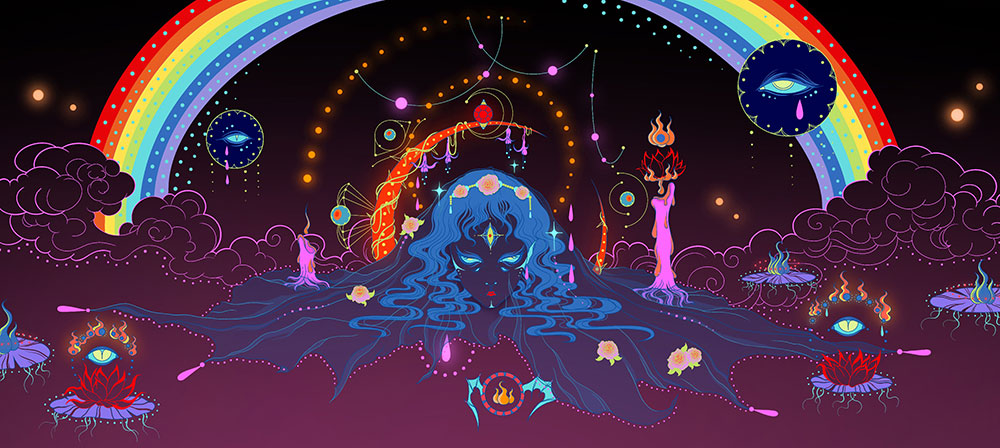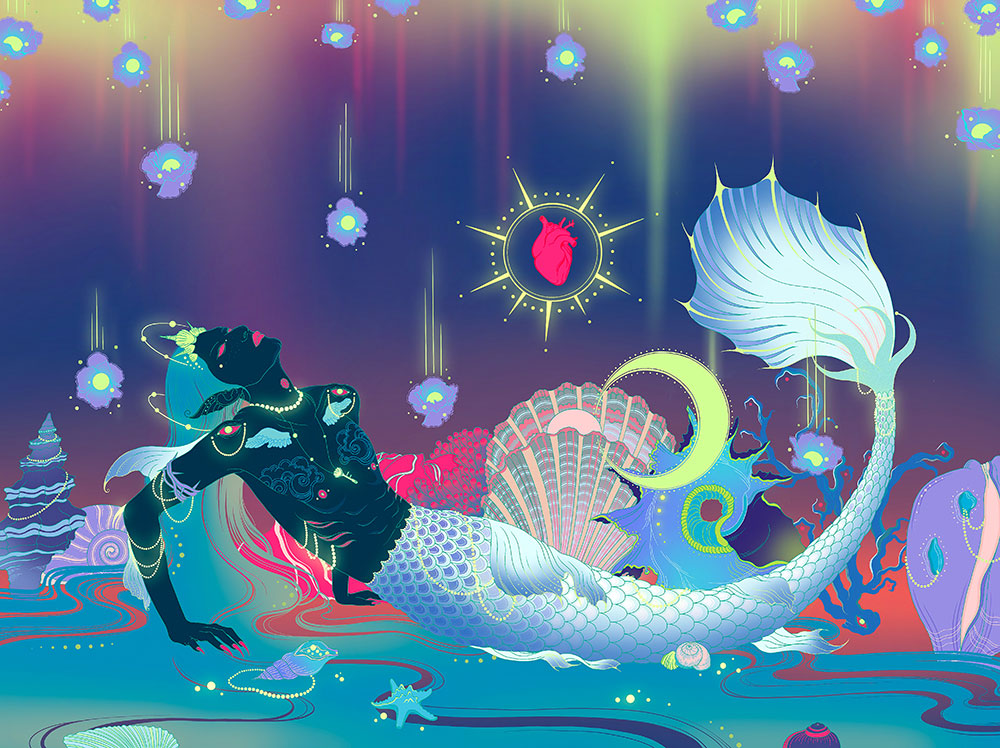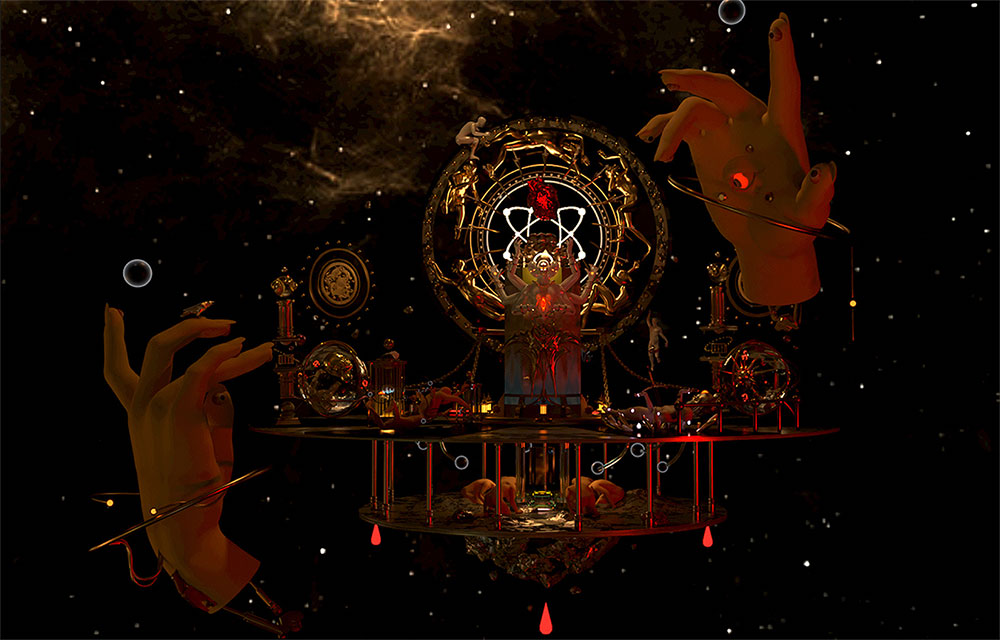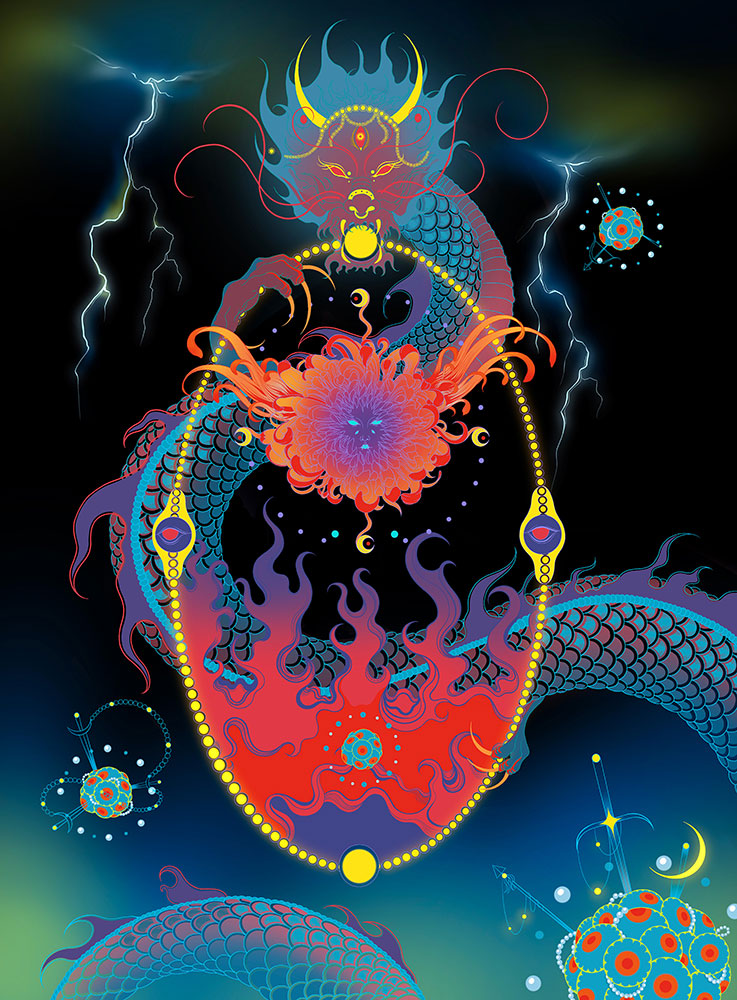China-born, London-based Keyi Liu is a Multimedia artist and Illustrator. Keyi’s practice spans multimedia art, 3D art, interactive installation, illustration, etc. Her works focus on creating creatures, and fantasy worlds and depicting the relationship between social development and people’s inner states through complex narratives.
Born: China
Now: London, UK
@edekiow | keyiliu-art.cargo.site | Linkedin
INTERVIEW
Keyi, what influenced your interest in visual art – your environment, family, or was it an internal drive?
“Resistance” and “dream” are the origins of my artistic creation. “Resistance” brings me the passion to create, while “Dreams” are like a shelter from the real world.
As a child, I used to dream every day. Compared to reality, the world in my dreams felt twisted and chaotic. This is probably where my visual art creation began. I believe the world is multidimensional, which leads me to fantasize about it. Another factor that influenced me was the education system I experienced. The education system before college was very strict and oppressive. Schools required students to have the same hairstyle, wear the same clothes, etc. When everyone stood together, you couldn’t tell them apart because they all looked the same.
This experience made me feel that I was trapped, with no autonomy at all. It was also this experience that established my thinking about “order”, “rules” and “constraints” in my artistic creation. I began to explore how the rules within social systems oppress the human spirit, fantasizing about creating a fantastical space somewhere in the universe where I could be free from constraints.
I think these are the two aspects which influence my art creation.

You’ve received education in the field of art on different continents. It was the School of Visual Arts in New York, USA, followed by a college in London, UK. What experiences with cultural influences and educational systems have you gained, and what insights have you taken away for yourself?
My experiences at the School of Visual Arts (SVA) and University College London (UCL) were quite different. At SVA, my major is illustration. SVA offered a diverse range of courses, allowing students to explore various creative mediums. Instructors don’t define right and wrong and give students the freedom to express themselves. If studying at SVA pioneered my artistic style and mindset, my studies at UCL further developed and refined these ideas to be more rigorous and logical. At UCL, my major is Design for Performance and Interaction. This program focuses on research skills, thus training my critical thinking. I also explored many technological creative areas at UCL, such as mechanical structures, interactive installations, and coding. Living and studying in these two countries provided me with experiences that not only helped me become a better artist but also influenced my personality. Through this journey, I’ve become more embracing of the diverse possibilities in both my life and art creation. It has been an immensely beneficial experience for me.

Currently, you are actively working on interactive and visual art. Could you share the themes of your works and what inspires you?
My works usually revolve around the theme of various societal constraints on humanity. I enjoy exploring the confrontational relationship between order and nature, as it drives people to contemplate their lives and themselves, making it an intriguing topic.
For instance, I am currently working on a project named ‘Heavenly.’ This project is an immersive experience inspired by the concept of ‘consciousness uploading.’ People mistakenly idealize digital immortality as utopian, believing that it helps them break the boundaries of the physical body and time, granting them infinite power. It also allows people to escape the reality of suffering and enter a world of happiness. However, people often ignore the limitations of different social orders. The transformation between life forms does not erase the dilemmas faced by individuals but rather transforms them into another form of continued existence.
This project seeks to remind people of the potential dangers of unknown life forms and the importance of maintaining a balance between the spiritual and physical realms in the digital age.
Your works often draw inspiration from nature, evident from the early work “Poem of Wood” (Generative Art) to your current illustrations featuring cosmogonic plots with mermaids and dragons. How do you successfully maintain a consistent line or style despite the diversity of mediums?
“Order” has always been a topic I explore in my work. I believe that art requires a medium used to convey the artist’s attitude. “Nature” is the medium I choose, and these two aspects are consistent in most of my works. Whether it’s plants or animals, although nature’s way is also based on order, it is simpler and freer than human society. The natural order resembles a system born of primitive desires. In my series “Poem of Wood,” I express my reverence for trees. They are resilient but mysterious. The “Poem of the Wood” describes the tree elves, who have stood in the forest for countless ages, yet can tolerate all the absurdities born in the world with a calm heart. They form a romantic nature poem.
The illustration series “The Last Dream” is an extension of my exploration of this theme. In this series, I designed various fantasy creatures and environments, creating an entirely new world order. In this illusionary world, rules are broken, time and space are intertwined chaotically. I do an imagination, if we break free from the strict order and grant utmost freedom to natural objects, can we attain a romantic hallucinatory space?

What are you currently working on, and in which projects do you plan to participate?
I’m currently a freelancer based in London, working on interactive and visual design projects. The rest of the time, I travel to New York and Beijing for exhibitions and art fairs. I’ve been interested in making interactive installations since I graduated. Since most of my works are presented as print or screen, which range from illustrations to generative arts to 3D animations, I’ve come to realize the importance of ‘narrativity’ and ‘environmental space’ throughout their creation process. This got me thinking about interactive installations. During my graduate studies, I delved into exploring how to establish environmental spaces and the interactions between the audience and artworks within a certain space.
So, at this stage, I’m making this an important point in my artistic exploration. I plan to build interactive installations based on visual design to create a narrative space and provide a multi-sensory interactive experience for audiences.

Finally, what advice would you give to aspiring artists on finding their own voice?
Artistic creation is a journey of self-discovery. The viewpoints expressed by artists, whether they are expressions of personal emotions or discussions on social issues are based on their values. Therefore, understanding oneself is crucial, as it helps artists develop a unique artistic style.
Additionally, many artists are perfectionists in their artistic creations. They always expect their work to be as perfect as possible before presenting it to galleries or audiences. But in fact, it is hard to reach a perfect moment, which will cause artists to miss the opportunities to show their work.
Artworks possess their own unique charm at each stage of development. Emotions are phases, and when we pass through a certain period, things become different, and it is difficult for us to get back to the original emotions and feelings. That’s why artmaking is fascinating and unique at all stages. We should record them confidently and present them to the audience.